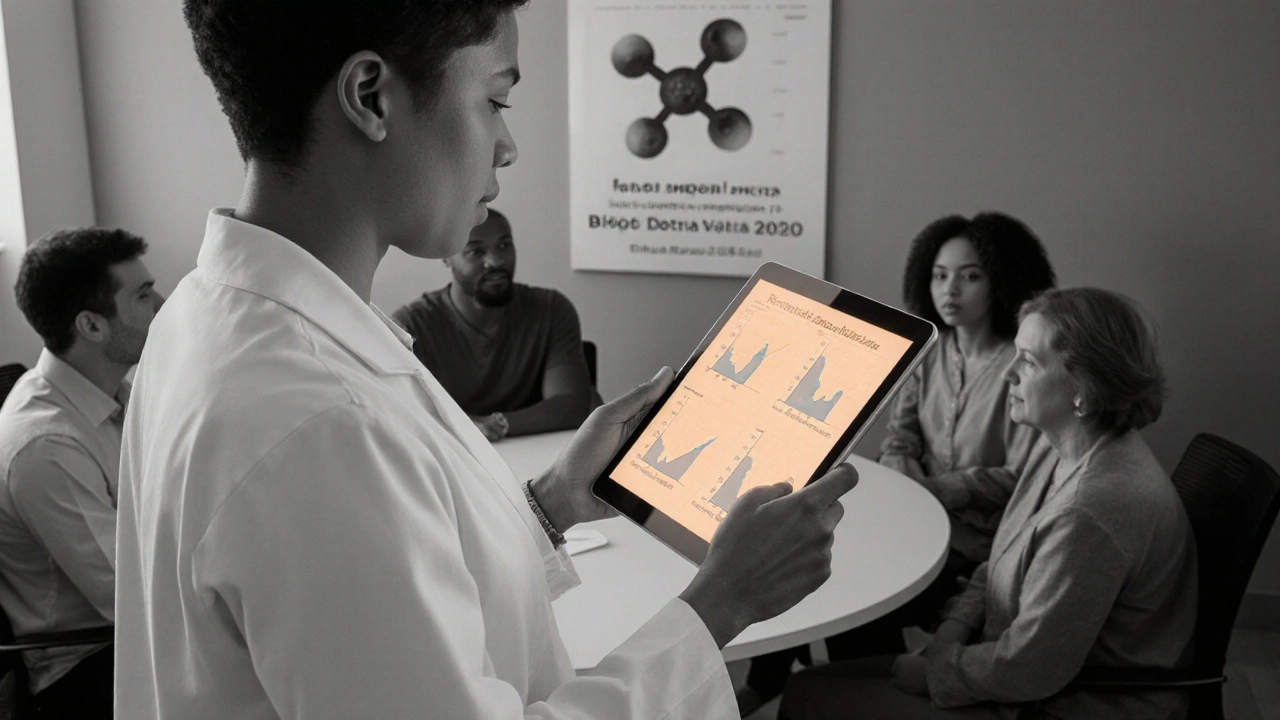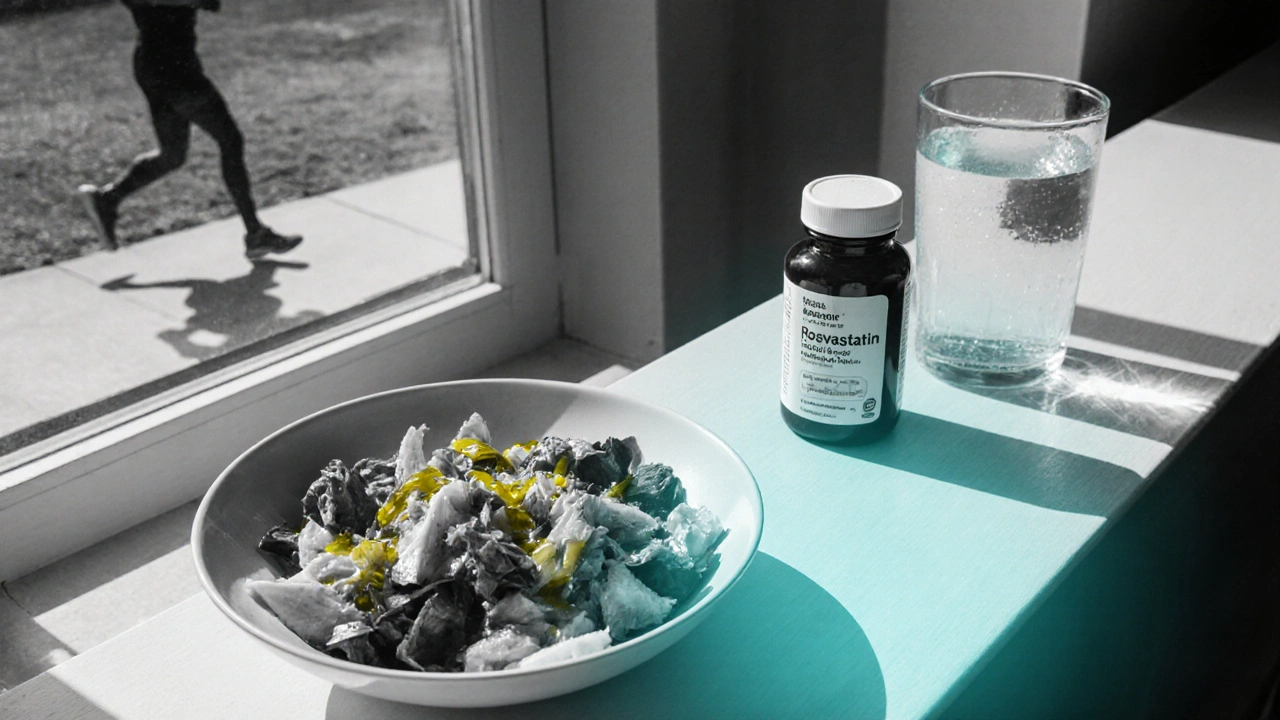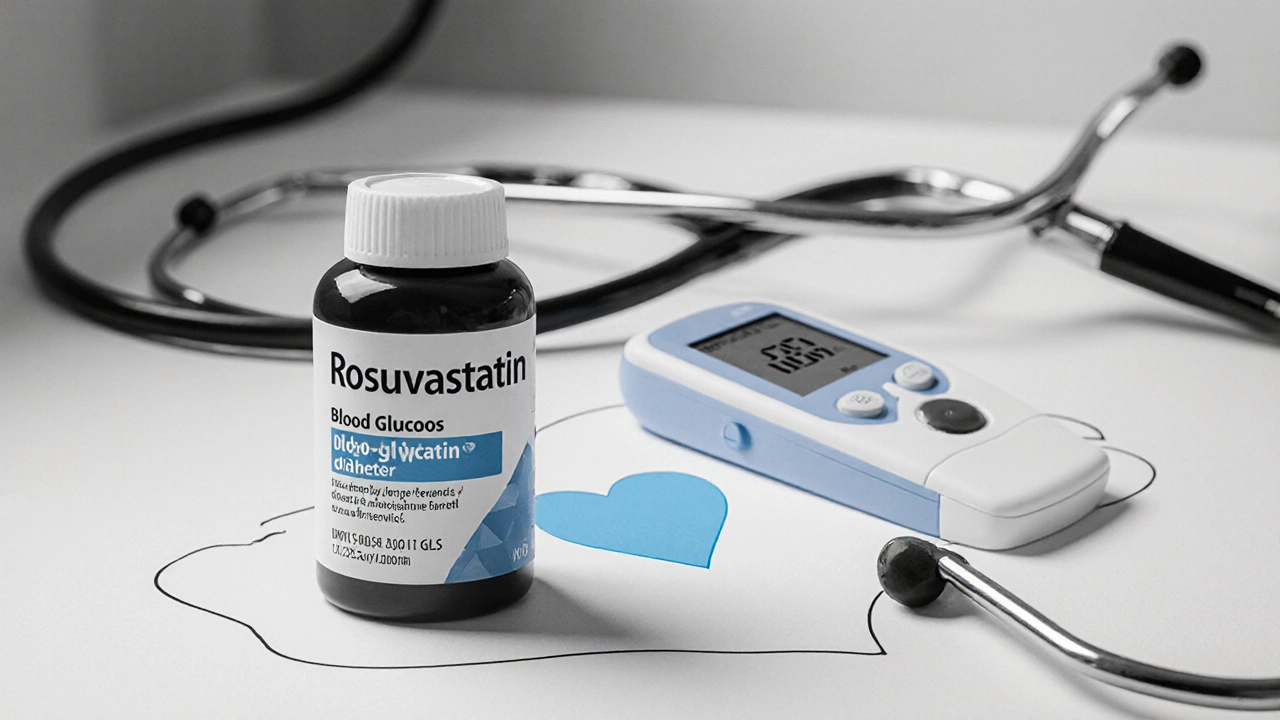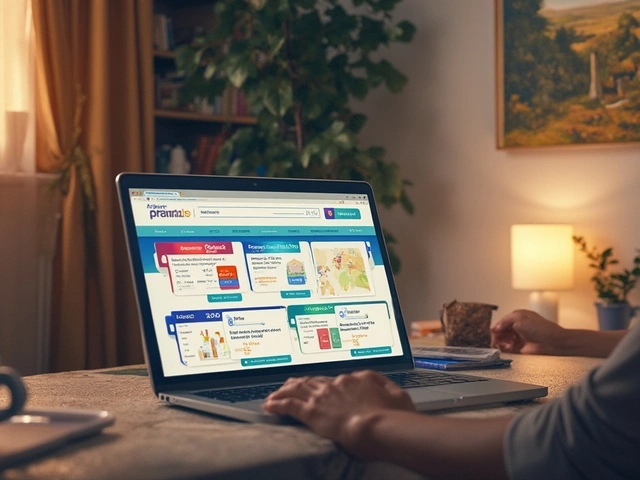Rosuvastatin and Diabetes: Essential Facts You Need to Know
Rosuvastatin Blood Sugar Calculator
Rosuvastatin may cause a modest increase in blood sugar levels. Based on clinical evidence, this calculator estimates your potential HbA1c change and fasting glucose impact.
Expected Changes
Based on JUPITER & HOPE-3 trialsAverage HbA1c increase
+0.18%
Average fasting glucose increase
+0.15 mmol/L
Your Estimated Results
Expected HbA1c
--
Expected Glucose
--
Clinical Guidance
- Check blood sugar every 3-4 weeks for first 3 months
- Report HbA1c increases >0.5% to your doctor
- Continue diabetes medications like Metformin
If you’ve been prescribed rosuvastatin and you also have diabetes, you’ve probably wondered whether the two mix well. The short answer is that the combination is generally safe, but a few nuances matter. Below we break down how rosuvastatin works, what diabetes means for cholesterol control, and what the latest research tells us about blood‑sugar changes.
What is rosuvastatin?
Rosuvastatin is a synthetic, high‑potency statin medication that lowers LDL cholesterol by inhibiting the HMG‑CoA reductase enzyme in the liver. By reducing low‑density lipoprotein (LDL) levels, it cuts the risk of heart attacks, strokes, and other cardiovascular events. Because it’s more potent than many older statins, doctors often start patients on a lower dose to achieve the same cholesterol drop.
Understanding diabetes mellitus
Diabetes mellitus is a chronic condition where the body can’t properly regulate blood glucose, either due to insufficient insulin production (type1) or insulin resistance (type2). The disease raises the risk of heart disease, kidney failure, and nerve damage. Managing blood sugar (often measured as fasting glucose or HbA1c) is the core of diabetes care.
How statins affect blood sugar
Statins, including rosuvastatin, are primarily aimed at cholesterol, but they can also influence glucose metabolism. The mechanism isn’t fully understood, but several theories exist:
- Statins may slightly increase insulin resistance in muscle cells.
- They can affect pancreatic beta‑cell function, modestly reducing insulin secretion.
- Some statins raise the level of LDL cholesterol a type of “bad” cholesterol that contributes to plaque buildup in arteries, which indirectly worsens metabolic health.
Overall, the rise in blood glucose is small-usually a rise of 0.1-0.2mmol/L in fasting glucose or a 0.2-0.3% increase in HbA1c. For most patients, the cardiovascular benefit far outweighs this modest change.

Clinical evidence on rosuvastatin and diabetes
Large trials such as the JUPITER and HOPE‑3 studies provide the best picture. In JUPITER, participants on rosuvastatin 20mg saw a 0.2% rise in HbA1c on average, yet the trial reported a 20% reduction in major cardiovascular events. A 2023 meta‑analysis of 13 statin trials (including rosuvastatin) found:
| Statin | Average HbA1c change | Average fasting glucose change (mmol/L) |
|---|---|---|
| Rosuvastatin | +0.18% | +0.15 |
| Atorvastatin | +0.13% | +0.12 |
| Simvastatin | +0.09% | +0.08 |
The numbers confirm rosuvastatin has a slightly higher glucose impact than some peers, but the difference is minimal. Importantly, participants with pre‑existing diabetes did not experience a higher rate of severe hyperglycemia or diabetic complications.
Practical guidance for patients on rosuvastatin
Here’s a checklist you can follow if you’re juggling rosuvastatin and diabetes:
- Know your baseline. Record fasting glucose and HbA1c before starting the statin.
- Monitor regularly. Check blood sugar every 3‑4weeks for the first three months, then every 3‑6months.
- Stay on your diabetes meds. Drugs like Metformin the first‑line oral medication for type2 diabetes that improves insulin sensitivity often counterbalance any statin‑related rise in glucose.
- Watch for symptoms. Increased thirst, frequent urination, or blurry vision could signal a glucose spike.
- Adjust lifestyle. A diet rich in fiber, regular exercise, and weight management help both cholesterol and blood sugar.
- Talk to your doctor. If HbA1c rises by more than 0.5% after three months, the clinician may consider lowering the statin dose or switching to a different agent.
Managing cardiovascular risk in diabetes
Diabetes itself multiplies heart disease risk. Even a small LDL reduction translates into big gains for people with high blood‑sugar levels. Studies show that every 1mmol/L drop in LDL can cut heart‑attack risk by about 20% in diabetic patients. Because rosuvastatin achieves the deepest LDL cuts-often >50% at moderate doses-its cardiovascular payoff is especially valuable.
Balance is the key: keep cholesterol low, keep glucose stable. The two goals often reinforce each other when you adopt a heart‑healthy diet (think Mediterranean style) and stay active.

When to consider alternatives
If you experience any of the following, discuss alternatives with your prescriber:
- Repeated fasting glucose >10mmol/L despite optimal diabetes therapy.
- New‑onset muscle pain or weakness (a rare but serious statin side effect).
- Severe liver enzyme elevation (ALT/AST >3× ULN).
Switching to a less potent statin like pravastatin, which has a lower impact on glucose, might be an option. However, be aware that the cholesterol‑lowering power will also be reduced, so your doctor may need to adjust the dose or add another lipid‑lowering drug.
Key takeaways
- Rosuvastatin effectively lowers LDL cholesterol and reduces heart‑attack risk, which is crucial for people with diabetes.
- It may cause a modest rise in blood‑sugar markers, typically <0.3% in HbA1c.
- Regular glucose monitoring, maintaining diabetes medication, and a healthy lifestyle keep the rise in check.
- Talk to your doctor if blood‑sugar jumps more than expected; a dose tweak or statin swap can help.
- The cardiovascular benefits usually outweigh the small glucose impact.
Frequently Asked Questions
Can rosuvastatin cause diabetes?
Statins, including rosuvastatin, can slightly increase the risk of developing type2 diabetes in people without the disease, but the absolute risk is low. For most patients, the heart‑protective benefits outweigh this risk.
How often should I check my blood sugar after starting rosuvastatin?
Measure fasting glucose or HbA1c before beginning therapy, then re‑check every 3‑4weeks for the first three months. After that, a 3‑6‑month interval is usually sufficient unless your doctor advises otherwise.
Is rosuvastatin safe during pregnancy for women with diabetes?
Rosuvastatin is classified as Pregnancy Category X, meaning it can harm a developing fetus. Women who are pregnant or planning pregnancy should avoid rosuvastatin and discuss safer lipid‑lowering options with their healthcare provider.
What lifestyle changes boost both cholesterol and glucose control?
Eating a Mediterranean‑style diet (lots of vegetables, whole grains, fish, olive oil), exercising at least 150minutes a week, losing excess weight, and quitting smoking all improve LDL levels and insulin sensitivity.
Should I stop rosuvastatin if my HbA1c rises?
Don’t stop it on your own. Talk to your doctor; they may adjust the dose, add another cholesterol‑lowering drug, or switch statins while reinforcing diabetes management.





16 Comments
Tiffany Owen-Ray
October 16 2025First of all, kudos for laying out the rosuvastatin‑diabetes interplay so clearly. It’s easy to feel overwhelmed when juggling cholesterol meds and blood‑sugar numbers, but remember that the heart‑protective benefits often outweigh a tiny uptick in glucose. Keep a diligent log of your fasting glucose before you start the statin, then check every few weeks as the article suggests. If you notice a steady rise, a modest dose adjustment or a switch to a slightly less potent statin can be discussed with your clinician. Meanwhile, focus on fiber‑rich foods, regular walks, and staying hydrated – these lifestyle pillars support both lipid and glucose control. Stay patient with the process; health is a marathon, not a sprint.
Jill Brock
October 20 2025This "essential facts" piece reads like a sloppy hype‑train.
Juan Sarmiento
October 24 2025Great summary! I love how you highlighted the actual numbers from JUPITER – the +0.18% HbA1c change is pretty modest compared to a 20% drop in heart events. For anyone on rosuvastatin, pairing it with Metformin or a good diet can keep that glucose bump in check. Also, don’t forget to ask your doctor about checking liver enzymes periodically; it’s a simple precaution. Keep sharing these evidence‑based updates, they’re super helpful for the community.
Patrick McVicker
October 28 2025Hey there, nice rundown! 👍 The only thing I’d add is a reminder to watch for muscle aches – they can be a red flag. And maybe drop a link to a glucose‑tracking app for folks who want to stay on top of numbers. Keep the info coming, it’s solid stuff.
Liliana Phera
October 31 2025While the data may appear reassuring, one must question the very premise of accepting any statin‑induced glucose rise without scrutinizing the underlying metabolic trade‑offs. The subtle elevation in HbA1c, though numerically small, reflects a deeper interference with insulin signaling pathways that we ought not to trivialize. Moreover, the pharmaceutical narrative often downplays long‑term ramifications in favor of short‑term cardiovascular gains. It is incumbent upon patients to demand transparency and consider lifestyle interventions as primary defenses. Accepting a medication that nudges your blood sugar upward should be a deliberated, not reflexive, choice.
Poorni Joth
November 4 2025i cant beleive how smmothly this article explain the risk. its realy helpfull for peopple who cant read these med becuse of big words. im a diabetic and i think this info i der got it better now. thanks for sharing!
Yareli Gonzalez
November 8 2025Thanks for the clear checklist. It makes it easier to stay on track with labs and appointments.
Alisa Hayes
November 12 2025The piece does a good job summarizing the key points, but a minor correction: “participants on rosuvastatin 20mg saw a 0.2% rise in HbA1c on average” could be phrased as “participants taking rosuvastatin 20 mg experienced an average 0.2 % rise in HbA1c.” Small edits like this improve readability.
Mariana L Figueroa
November 15 2025Useful info keep monitoring glucose levels and keep LDL low
Diane Helene Lalande
November 19 2025I appreciate the balanced view presented here. The data tables are especially helpful for quick reference. Looking forward to more updates on statin alternatives for those who experience higher glucose spikes.
Manju priya
November 23 2025Dear readers, the evidence presented underscores the importance of vigilant monitoring when initiating rosuvastatin therapy. Please ensure that your HbA1c and fasting glucose are recorded prior to commencement, and schedule follow‑up assessments at the recommended intervals. Should values exceed the anticipated range, a consultation with your healthcare provider is warranted to consider dose modification or alternative lipid‑lowering strategies. 😊 Maintaining both cardiovascular and glycemic health is achievable with disciplined adherence to these guidelines.
Jesse Groenendaal
November 27 2025Honestly this article misses the point it glosses over the ethical dilemma of prescribing drugs that tweak your metabolism without full consent it feels like a profit‑driven narrative
Persephone McNair
December 1 2025From a pharmacovigilance standpoint the risk‑benefit calculus here is clear yet the discourse often lacks granular pharmaco‑dynamic insight which could empower clinicians to tailor therapy more precisely
siddharth singh
December 4 2025When evaluating rosuvastatin in the context of diabetes, it is essential to adopt a multidimensional perspective that integrates pharmacologic potency, metabolic side‑effects, and patient‑centered outcomes. First, rosuvatin’s high affinity for HMG‑CoA reductase translates into profound LDL reductions, often exceeding 50 % at moderate doses, a fact that alone can shift cardiovascular risk curves dramatically. Second, the modest elevation in fasting glucose-typically on the order of 0.1–0.2 mmol/L-should be interpreted against the backdrop of the absolute risk reduction in myocardial infarction, which can be as high as 20 % in high‑risk cohorts. Third, the underlying mechanism by which statins may impair insulin sensitivity remains incompletely elucidated, with hypotheses ranging from altered adipocyte gene expression to subtle mitochondrial dysfunction in skeletal muscle. Fourth, meta‑analytic data consistently demonstrate that the glucose‑raising effect is a class phenomenon, albeit more pronounced with rosuvastatin compared to pravastatin or fluvastatin. Fifth, clinical guidelines therefore advise baseline glycemic assessment prior to initiation, followed by periodic monitoring at three‑month intervals during the titration phase. Sixth, patients who exhibit a trajectory of HbA1c elevation greater than 0.5 % should engage in a shared decision‑making process to weigh the benefits of continued statin therapy against potential metabolic detriments. Seventh, lifestyle interventions-particularly a Mediterranean‑style diet rich in monounsaturated fats and soluble fiber-can blunt the statin‑induced glycemic shift while synergistically enhancing lipid profiles. Eighth, adjunctive glucose‑lowering agents such as metformin have been shown to offset the minor rise in HbA1c, providing a pharmacologic buffer that preserves cardiovascular protection without compromising glycemic control. Ninth, the hepatic safety profile of rosuvastatin remains favorable in the majority of patients, though clinicians must remain vigilant for transaminase elevations exceeding three times the upper limit of normal. Tenth, the risk of myopathy, while low, is not negligible; patients should be counseled to report unexplained muscle pain promptly. Eleventh, emerging data on PCSK9 inhibitors suggest a future where lipid lowering can be achieved without affecting glucose metabolism, offering an alternative for statin‑intolerant individuals. Twelfth, cost considerations also play a role, as newer agents may carry higher out‑of‑pocket expenses that influence adherence. Thirteenth, shared decision‑making tools that incorporate individual risk calculators can personalize therapy, aligning treatment intensity with patient preferences. Fourteenth, in practice, many clinicians find that the net clinical benefit of rosuvastatin remains positive even in diabetic populations, provided that monitoring protocols are strictly followed. Fifteenth, ongoing research is required to clarify long‑term outcomes, especially in diverse ethnic groups where baseline metabolic risk may differ. Finally, the overarching message is clear: rosuvastatin can be safely used in diabetes when clinicians adopt a proactive monitoring strategy, educate patients about potential glycemic changes, and remain prepared to adjust the therapeutic regimen as needed.
Angela Green
December 8 2025Great effort on the summary! Just a quick note: “keep a diligent log” should be “keep a diligent log of your fasting glucose,” and “heart‑protective benefits” could be hyphenated as “heart‑protective.” Also, “health is a marathon, not a sprint” is a cliché; consider rephrasing for originality. Overall, solid work!
April Malley
December 12 2025Wow, what a thought‑provoking take!,,, I completely agree that we shouldn't just accept any medication without questioning the deeper metabolic impacts.,, It's so important to stay informed and discuss these nuances with our doctors.,, Thanks for sparking this conversation!